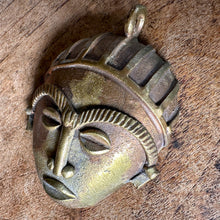There’s something unique about this crude looking brass mask made by the fabled Ashanti people of central Ghana.
Measuring 60x75mm – plus a 4mm eye bail, this striking pendant mask would make a terrific centerpiece when creating an ethnic tribal-styled or boho-inspired necklace.
The Ashanti and to a lesser degree the Baoule tribal people from the Ivory Coast create these beautiful brass and bronze masks using traditional lost-wax methods – the same labour-intensive metal-casting process that their forefathers used since the 3rd millennium BC.
And the results today are as stunning as they were two thousand years ago – confirming that by incorporating modern methods with ancient techniques, works exceptionally well.
Here we have a 60x75mm brass mask pendant – cast using the lost-wax technique and weighing in at 90 grams.
The accompanying photos illustrate what to expect in your order, though images may have
been enlarged to show detail, and colours may vary slightly due to lighting variants.
The Ashanti, Baoule, Krobo and Yoruba tribes are the main bead-making people of West Africa.
The main difference between the four ethnic groups, see the Krobos and Yoruba tribes specialise in bead-making with recycled glass, while the Ashanti and Baoule people prefer metal.
Lost-Wax casting is one of the oldest known metal-forming techniques in the world which date back more than 6,000 years – and the Ashanti have the technique perfected down to a veritable artform.
The bead-making process first calls for the construction of specially designed bead molds made out of waxed models - into which hot molten metal is poured.
The hot liquid causes the wax mold to melt and drain away - and in doing so the masks or beads are formed and created after the metal sets.
A proven technique that is so simple and so clever is why the lost-wax casting process has survived for so long.
It is well used in the 21st Century particularly by the dentistry industry, who use these ancient methods to create crowns, inlays and on lays – but with modern technology.




